There are a number of things to consider when selecting a bonsai pot – especially when preparing a tree for exhibit. The pot needs to blend into the composition, but depending on the exhibit, this could entail very different criteria. Garish glazes might be appropriate in a show that focuses on containers. More subtle selections might be best when displaying trees on their own. I’ll be showing the pine below in a 6′ space along with a second tree, possibly a Western juniper, and an accent plant. My goal is to create subtle harmony between each of the elements in the display – a tall order!
For this task, the most useful cues for selecting a pot come from the tree itself. The style of this tree is hard to define, somewhere in the informal upright or slant neighborhood, but with a thin trunk. In the future I hope to create better balance between the trunk size and foliage. To do this I plan to reduce the foliage significantly. Improving the tree’s balance will make it easier to select an appropriate pot – maybe a nanban or 6-8 sided scalloped pot would be more appropriate for this future tree.
Today, however, the foliage requires a more substantial pot. The first option is a pretty good fit. The color complements pine well and the style is appropriate. If the lip of the pot were narrower – or the tree better endowed – It would be an even better fit.

Pot #1 – Chinese
The pot was actually a promotional affair from a Rendezvous event at Brussel’s Bonsai Nursery several years ago. Rendezvous is among my very favorite bonsai events in the US – if you haven’t been, I highly recommend it.
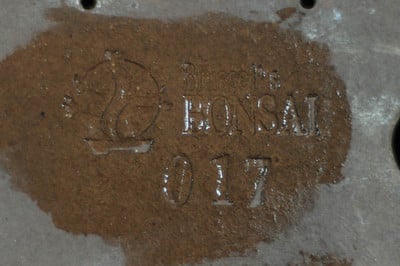
The “chop” of pot #1
The Yamaaki pot is another good option. It’s a conservative choice, but its width and tapered sides exaggerate the thin trunk. The oval shape is a great match for the soft silhouette of the tree and the color is good, if lacking in patina.
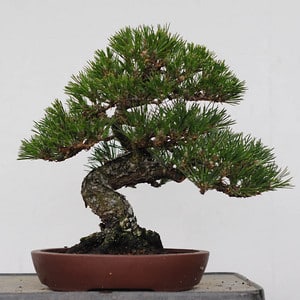
Pot #2 – Yamaaki
Gray is a good choice when you want to highlight pine bark. In this case the tree is young – 16 years old – and I’d rather downplay its youth by highlighting other aspects of the tree. If the trunk were a little bigger I’d find the size appropriate, but here it looks a bit large. As a result, the trunk looks to be too far left even though the foliage lines up well with the pot.
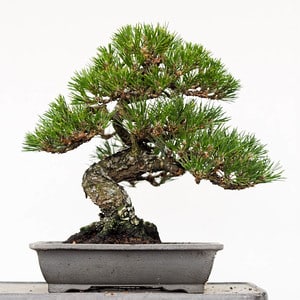
Pot #3 – Chinese
The Japanese pot below is a good size and shape for the tree, but it’s strikingly bright. Although it’s 30-40 years old, it looks like it hasn’t aged a day. Better quality clay and/or increased exposure to the elements would show age better and make it a better match.
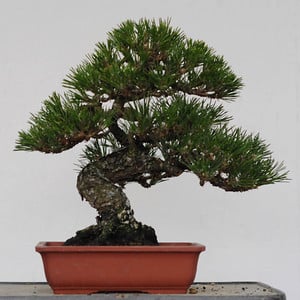
Pot #4 – Sakura
The Chinese pot below has one of the most important characteristics a pot can have – it’s old. Like so many BIB adherents, I’m a sucker for old pots. However, because the pot is in good shape, the age doesn’t show much, which slightly decreases its appeal. Both shape and color are appropriate, though more pronounced feet might make the tree stand out better – good if this serves as the “primary” tree in the display, less compelling if it serves as the “second” tree.
The rankings “primary” and “secondary” refer to the relative quality of the trees in a display. When two or more trees are shown in the same display, one will typically be more outstanding than the others. Sometimes the primary tree is the larger and sometimes it’s the smaller – quality, and not size, is the deciding factor.
Although it doesn’t show in the photo, the pot is also quite narrow. This can make trimming the rootball a challenge.
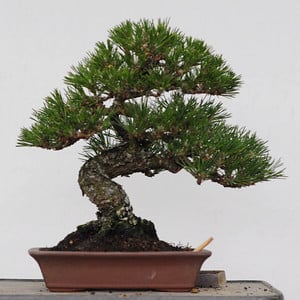
Pot #5 – Chinese
I really like this Japanese pot. It’s old, and although it’s hard to see without zooming in, the clay contains light-colored flecks that provide a nice texture. The curves are a great fit for the trunk and the feet offer good elevation. It’s also small. This may become a great option when I reduce the foliage.
In many respects it’s one of the “best” pots shown here – it has good clay, good color, good age, and nice design. In other words, it’s more expensive than the others. Unfortunately price doesn’t help with the fit.
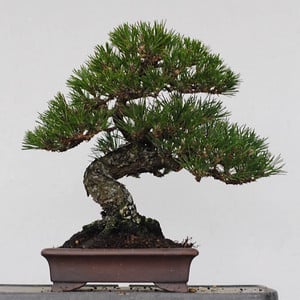
Pot #6 – Japanese
I appreciate that the Bunzan received more comments than the other pots. And I want to say it’s a tongue-in-cheek entry, but there are cases in which this pot would be a really fun choice. It will most likely see action as a container for an accent, but I’d love to see it displayed with the right tree. The size and shape are surprisingly appropriate here.
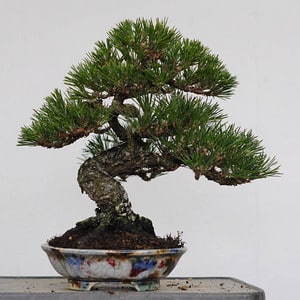
Pot #7 – Bunzan
Which leaves us with the nanban. A little smaller than I’d like, and a bit less formal than will fit with the display I have in mind, but another intriguing alternative. Round does a good job of highlighting the tree’s soft outline and is appropriate for the bunjin-sized trunk.
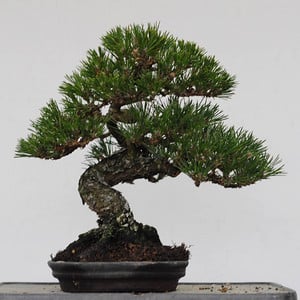
Pot #8 – Nanban
So clearly I chose #5, the reddish-brown Chinese pot. I’ll have photos soon that show the repotting and moss-work for the exhibit.
I’d also like to thank Tom K. for a perfect segue for next week’s post – the story behind the name “Bonsai Tonight.” Tom mentioned how perfectly a plastic bear accent belonging to one H. Smith would complement a pine potted in the Bunzan. This immediately reminded me of a similar accent Smith procured for BIB’s 6th annual show. It was the handful of photos taken while we set up this exhibit, amont other factors, that ultimately led to this site. Thanks Tom!
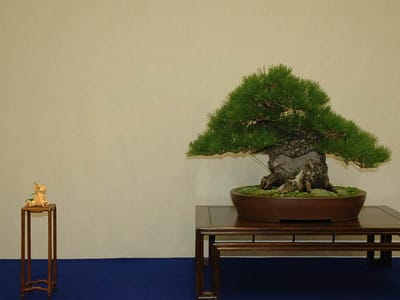
Subscribe to Bonsai Tonight
New Posts Delivered Every Tuesday and Friday
John Kirby says
Good CHoice, very nice commentary on the process of matching a tree and a pot and how it ultimately comes down to how the composition makes you feel.
Jonas, the Bunzan pot reminds of the time in 2006 when a couple of wayward troublemakers repotted Morten Wellhaven’s beautiful JBP show pine in to a perfectly shaped, very green (and highly glazed) pot. When he came back to see the work we had done I thought he was he going to, perhaps, have an “event”. After the joke was completed, we repotted his tree into a very fine unglazed Japanese container.
I think you could use a bright Bunzan or similar container with a more feminine shohin/Mame JBP if it weren’t going to be the principal tree in a group display.
John
xwires says
Thank goodness the “event” was averted! I agree – I think we’ll start finding more uses for non-conventional pot-tree combinations in coming years. Because even if we ultimately find the experiment to be wrong-headed, it will be hard to know until we give it a try.
And besides, a little provocation can be a good thing on occasion.
AlexV says
If you mentioned, I didn’t catch it. Is this tree going to be the primary tree or secondary? My guess is the secondary with the tall Bunjin Juniper as the primary, but is that the combo you are using?
Great post, was fun to look at the pots and guess which one would be appropriate.
xwires says
Thanks. If I show it with the Western, it will be the second tree. I won’t be sure about the final setup until the show comes together. We’ll see this weekend!